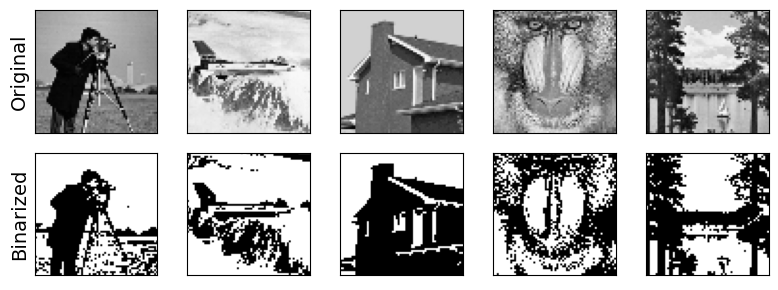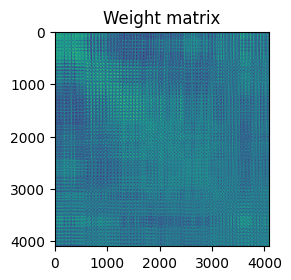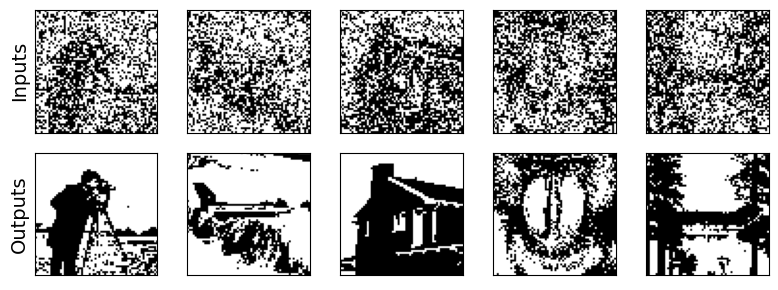Hopfield モデル
Contents
Hopfield モデル#
[Hopfield, 1982]で提案.始めは1と0の状態を取った.
Hopfieldモデルと呼ばれることが多いが,Amariの先駆的研究[Amari, 1972]を踏まえAmari-Hopfieldモデルと呼ばれることもある.
次のような連続時間線形モデルを考える.シナプス前活動を\(\mathbf{x}\in \mathbb{R}^n\), 後活動を\(\mathbf{y}\in \mathbb{R}^m\), 重み行列を\(\mathbf{W}\in \mathbb{R}^{m\times n}\)とする.
ここで\(\dfrac{\partial\mathcal{L}}{\partial\mathbf{y}}:=-\dfrac{d\mathbf{y}}{dt}\)となるような\(\mathcal{L}\in \mathbb{R}\)を仮定すると,
となる. これをさらに\(\mathbf{W}\)で微分すると,
となり,Hebb則が導出できる.
モデルの定義#
using Base: @kwdef
using Parameters: @unpack
using LinearAlgebra, PyPlot, Random, Distributions, Statistics, ImageTransformations, TestImages, ColorTypes
@kwdef mutable struct AmariHopfieldModel
W::Array # weights
θ::Vector # thresholds
end
# Training weights & definition of model
function AmariHopfieldModel(inputs; σθ=1e-2)
num_data, num_units = size(inputs) # inputs : num_data x num_unit
inputs = mapslices(x -> x .- mean(x), inputs, dims=2)
W = (inputs' * inputs) / num_data # hebbian rule
W -= diagm(diag(W)) # Set the diagonal of weights to zero
return AmariHopfieldModel(W=W, θ=σθ*randn(num_units))
end;
binarize(img) = 2.0((img .- mean(img)) .> 0) .- 1; # img to {-1, 1}
function corrupted(img, p=0.3)
mask = rand(Binomial(1, p), size(img));
return img .* (1 .- mask) - img .* mask;
end
corrupted (generic function with 2 methods)
データセットの作成#
testimagelist = ["cameraman", "jetplane", "house", "mandril_gray", "lake_gray"]; # gray & size(512 x 512)
num_data = length(testimagelist)
imgs = [convert(Array{Float64}, imresize(Gray.(testimage(imagename)), ratio=1/8)) for imagename in testimagelist];
imgs_binarized = map(binarize, imgs);
imgs_corrupted = map(corrupted, imgs_binarized);
input_train = reshape(cat(imgs_binarized..., dims=3), (:, num_data))';
input_test = reshape(cat(imgs_corrupted..., dims=3), (:, num_data))';
figure(figsize=(8, 3))
for i in 1:num_data
subplot(2, num_data, i); imshow(imgs[i], cmap="gray");
xticks([]); yticks([]); if i==1 ylabel("Original", fontsize=14) end;
subplot(2, num_data, i+num_data); imshow(imgs_binarized[i], cmap="gray");
xticks([]); yticks([]); if i==1 ylabel("Binarized", fontsize=14) end;
end
tight_layout()

モデルの定義と訓練#
model = AmariHopfieldModel(input_train);
figure(figsize=(3, 3))
title("Weight matrix"); imshow(model.W);
tight_layout()

画像の復元#
エネルギー関数
を最小化するように内部状態 \(\mathbf{s}\) を更新.
energy(W, s, θ) = -0.5s' * W * s + θ' * s
# Synchronous update
function prediction(model::AmariHopfieldModel, init_s, max_iter=100)
@unpack W, θ = model
s, e = init_s, energy(W, init_s, θ)
for t in 1:max_iter
s = sign.(W * s - θ) # update s
e_tp1 = energy(W, s, θ) # compute state (t+1) energy
if abs(e_tp1-e) < 1e-3 # convergence
return s
end
end
return s
end;
imgs_predicted = [reshape(prediction(model, input_test[i, :]), (64, 64)) for i in 1:num_data];
figure(figsize=(8, 3))
for i in 1:num_data
subplot(2, num_data, i); imshow(imgs_corrupted[i], cmap="gray");
xticks([]); yticks([]); if i==1 ylabel("Inputs", fontsize=14) end;
subplot(2, num_data, i+num_data); imshow(imgs_predicted[i], cmap="gray");
xticks([]); yticks([]); if i==1 ylabel("Outputs", fontsize=14) end;
end
tight_layout()

稠密連想記憶 (dense associative memory) モデル#
**Dense Associative Memory (DAM)**モデル(Modern Hopfield networksとも呼ばれる).
Krotov, Dmitry, and John J. Hopfield. 2016. “Dense Associative Memory for Pattern Recognition.” arXiv [cs.NE]. arXiv. http://arxiv.org/abs/1606.01164.
Krotov, Dmitry, and John Hopfield. 2018. “Dense Associative Memory Is Robust to Adversarial Inputs.” Neural Computation 30 (12): 3151–67.
Krotov, Dmitry, and John J. Hopfield. 2019. “Unsupervised Learning by Competing Hidden Units.” Proceedings of the National Academy of Sciences of the United States of America 116 (16): 7723–31.
Ramsauer, Hubert, Bernhard Schäfl, Johannes Lehner, Philipp Seidl, Michael Widrich, Thomas Adler, Lukas Gruber, et al. 2020. “Hopfield Networks Is All You Need.” arXiv [cs.NE]. arXiv. http://arxiv.org/abs/2008.02217.
深層ニューラルネットワークへの応用.
Krotov, Dmitry, and John J. Hopfield. 2020. “Large Associative Memory Problem in Neurobiology and Machine Learning.” https://openreview.net › Forumhttps://openreview.net › Forum. https://openreview.net/pdf?id=X4y_10OX-hX.
“Hopfield Networks Is All You Need.”の論文における非生理学的3ニューロン相互作用の緩和.
参考文献#
- Ama72
S-I Amari. Learning patterns and pattern sequences by Self-Organizing nets of threshold elements. IEEE Trans. Comput., C-21(11):1197–1206, November 1972.
- Hop82
J J Hopfield. Neural networks and physical systems with emergent collective computational abilities. Proc. Natl. Acad. Sci. U. S. A., 79(8):2554–2558, April 1982.

